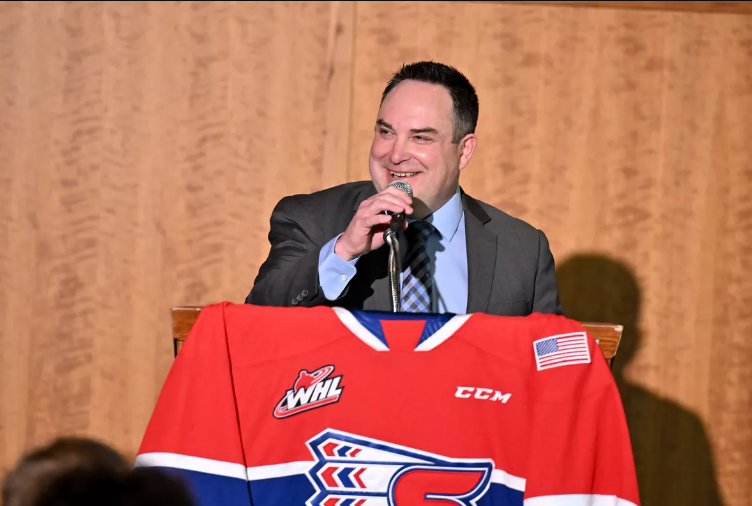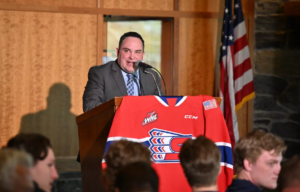
Spokane Chiefs GM Matt Bardsley reacts to NCAA opening college hockey eligibility to major junior players

The recent decision by the NCAA to allow players from the Canadian Hockey League (CHL) to become eligible for college hockey starting in the 2025-26 season is one of the most significant changes to the sport in recent memory. This landmark shift opens the door for players from the Ontario Hockey League (OHL), Quebec Major Junior Hockey League (QMJHL), and Western Hockey League (WHL) to pursue NCAA Division I hockey while still playing in major junior leagues, something that was previously not possible due to the NCAA’s eligibility rules. For years, these players had been considered “professionals” in the eyes of the NCAA, which barred them from participating in college hockey. With this new rule in place, the dynamic of player development in North American hockey could change in profound ways.
One of the teams most impacted by this change is the Spokane Chiefs, a WHL team based in Spokane, Washington. As a franchise that has spent decades developing some of the top young hockey talent in North America, the Chiefs now find themselves in the midst of a shifting landscape. The new NCAA rule means that Spokane’s players who are in the post-high school stage will have the opportunity to make a direct transition to NCAA hockey, if they so choose, after their time in the WHL. This is a welcome change for many players and families who have previously faced a tough decision between playing major junior hockey or committing to a college program.
In an exclusive interview, Spokane Chiefs General Manager Matt Bardsley shared his thoughts on the historic rule change and what it means for the franchise. His comments reflect both the excitement and uncertainty surrounding this pivotal moment in hockey development, especially as the potential long-term consequences remain unclear.
“Today’s announcement that CHL players will now be eligible to compete in NCAA D1 Hockey beginning in the 2025-26 season represents a historic and consequential outcome that will be celebrated by all of those invested in the on- and off-ice development of young players,” said WHL Commissioner Dan Near in a release about the decision. For the Chiefs, Bardsley expressed cautious optimism, noting that this change could create new opportunities for players, but he was careful not to overstate its impact on the team’s approach. “It’s all about the players,” he said. “I think it’s good as we get to know more of the details. A lot of the players in our league, the post-graduate players, if they wanted to continue on to university … now there’s this option that they could continue to play NCAA hockey. I think it’s outstanding for that.”
Bardsley’s remarks underscore the fact that, at its core, the CHL’s mission is to help develop hockey players and young people, whether that means guiding them toward the NHL, college hockey, or professional hockey in Europe. For Bardsley and the Spokane Chiefs, this philosophical approach will not change with the new eligibility rules. The Chiefs have always been a franchise that emphasizes holistic player development, preparing their players not only for hockey at the highest levels but also for life beyond the rink. “Our No. 1 focus is to develop hockey players and people,” Bardsley explained. “We certainly want to win, and I think it goes hand in hand – if we’re developing the right way, it’s gonna help with our wins; if we’re winning, it helps development, as well.”
While the Spokane Chiefs have maintained their long-standing emphasis on development, this new rule introduces more complexity into the decision-making process for players, their families, and agents. For years, players who were considering major junior hockey faced the difficult decision of whether to pursue a career in the CHL or commit to the NCAA path. If they chose the CHL, they had to forgo their NCAA eligibility, effectively ruling out any possibility of playing college hockey. Now, with the NCAA’s rule change, players in the CHL will no longer be forced to make this decision so early in their careers. They can now play in the CHL, gain invaluable experience in major junior hockey, and then pursue NCAA hockey if they so choose, after their junior hockey career is complete.
Bardsley welcomed this change, noting that the flexibility it provides is a significant positive for young players. “Ultimately, it’s good that it doesn’t force players to have to make a decision,” he said. “For so many years now, for young players and families at 15, 16 years old, they have to decide what they’re going to do, how it’s going to affect them now and maybe down the road. Now, they don’t have to worry about that because it doesn’t affect you anymore.”
But while the rule change expands options for players, it also introduces new challenges for teams like the Spokane Chiefs. As Bardsley acknowledged, there will likely be some players who decide to leave junior hockey in favor of the college route. Specifically, players in their late teens or early twenties may now choose to pursue NCAA opportunities rather than remaining in the WHL for their final years of junior eligibility. This shift could mean that some players who previously would have stayed in the WHL to develop might opt for a college career instead.
“Will there be some players that maybe want to look at this option? Yeah, I think that just probably the nature of it,” Bardsley said. “It’s going to be new. People are going to be interested in it. I’m not going to be naive to think players aren’t going to look into it. But are there going to be a lot of players leaving? That’s hard to say.”
This uncertainty around the future of player retention is a natural concern for junior hockey teams, including the Spokane Chiefs. While the potential for more players to leave for NCAA programs is an unknown, it’s clear that the new eligibility rules could make the college route more appealing, particularly for players who are nearing the end of their junior careers and want to pursue a different path. This is especially true when considering the growing prominence of NIL (Name, Image, Likeness) deals in college athletics, which have the potential to make college hockey even more attractive to young players.
“It’s for sure a possibility,” Bardsley said, acknowledging the growing influence of NIL in college sports. “In the last few years, it’s become a very big trend in college sports. … It’s going to be an area that schools are certainly going to use to entice players, and I’m sure that’s something that’s intriguing.”
The rise of NIL money in college athletics adds another layer of complexity to the decision-making process for players. While the idea of NIL deals might not have been a consideration for players in the CHL before, it now becomes a factor that could influence whether a player stays in junior hockey or transitions to college. With major NCAA programs offering potential for NIL opportunities, this could make the allure of college hockey even stronger, particularly for older players looking to make the transition to the next level.
Despite these uncertainties, Bardsley remains cautiously optimistic about the overall impact of the rule change. “There’s still a lot of unknowns as to how this plays out, but I think it could be really good for everybody,” he said.
While it’s difficult to predict how the landscape of hockey development will evolve over the next few years, one thing is clear: the Spokane Chiefs and other WHL teams will need to adapt to the new reality. The flexibility that now exists for players in terms of choosing between the CHL and NCAA hockey will likely increase competition for top prospects, but it also creates more opportunities for those players who are torn between the two paths. For Bardsley and the Chiefs, this means that their focus on player development remains more important than ever. The Chiefs will continue to prioritize helping their players grow both on and off the ice, regardless of the route they ultimately take in their hockey careers.
However, the NCAA’s decision to open up college hockey eligibility to CHL players is a game-changer for the sport. It provides young players with more options, increases the potential for NCAA hockey to become an even more viable career path, and shifts the balance between major junior and college hockey. For the Spokane Chiefs, this rule change may create new challenges, but it also presents an opportunity to continue developing top talent in the WHL while helping players pursue their goals, whatever path that may take. As Bardsley said, “It’s all about the players,” and with more opportunities now available, the future of junior and college hockey looks brighter than ever.

Leave a Reply